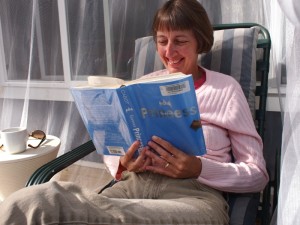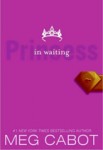
I love a good series. Who doesn’t, really? Betsy-Tacy by Maud Hart Lovelace, Harry Potter, Ally Carter’s novels, Louise Rennison’s hilarious Georgia Nicolson’s books…. And I have always been intrigued by how a series is put together. Much has been made of J.K. Rowling knowing from the beginning exactly how all seven HP books played out. And I believe it because there is stuff in book one that shows up again in book seven (although, as a writer myself, I understand that sometimes what seems planned is something the author finds to use later, as opposed to it being intentional).
Anyway, I decided to study a series that I’d read one book at a time as they came out, but hadn’t revisited – Meg Cabot’s The Princess Diaries. There are ten main novels, some supplementary books (of which I did not read all of this time), and a few novellas (I read the ones I could get my hands on). Once I decided to go forward with this experiment, I couldn’t wait to get started and ended up listening to the first four novels as downloadable audio books while waiting for the rest to come into the library.
I’m not going to go into specifics on each book. This is more about what I learned overall. First and foremost, I want to say that whatever your feelings on chicklit* might happen to be…okay, who am I kidding, this is for you chicklit snobs, I just want to say that Meg Cabot is a master at what she does. And it’s not as easy as it looks, which you will find out if you pick up any of the numerous other chicklit books out there that are only moderately successful, because they’re only moderately well-written.
 Okay, now that that’s out of the way. Here we go. For those of you who don’t know anything about the Princess Diaries (what rock are you living under? I mean…sorry), here’s a place to start.
Okay, now that that’s out of the way. Here we go. For those of you who don’t know anything about the Princess Diaries (what rock are you living under? I mean…sorry), here’s a place to start.
Five things I learned from studying this series:
- Simplicity is a beautiful thing – In each book, Princess Mia usually wants one thing, and she wants it badly, and she obsesses over it for the entire book, and everything else that happens thwarts her. This is Writing 101, but sometimes very hard to remember when you’re plotting your own book.
- Intentional repetition can be very funny (also, you can overdo it).
- The stronger books were when Princess Mia wanted something “girly” and Cabot countered that desire with a real world challenge. I almost gave up on the whole series over book four’s obsession with going to the prom and not much else to the story. However, I remembered what it was like to feel that way…you know you should be a feminist, and you know waiting on a boy is crazy, and yet…my fifteen-year-old self was just like that. Her stronger books deal with more though…books three and four felt like fillers to me. Princess Mia (number nine) is the strongest in my opinion, and the last one, Forever Princess, the most romantic and fulfilling!**

- Every single character is memorable, and dimensional. This is something I learned from Cabot a long time ago and have always strived for in my writing. I actually have written articles about it and teach a workshop based on creating unforgettable characters. Cabot is really, really good at this, and I’m reminded of it every time I read her.
- While I really enjoy reading chicklit, especially when I’m editing my own stuff, I don’t really see me writing it. And I don’t think I knew this. Part of me always thought someday I’d come up with a chicklit series and write it for fun (and profit? Haha!). But I don’t think so. I will leave it to the masters!
It also didn’t take me long to realize why I love these books so much…because OMG! I am Princess Mia. Well, not exactly, there’s the whole I’m not an actual princess thing. But back in high school, like Princess Mia, I was:
- Five foot nine, skinny as a rail, and totally flat-chested.

- My hair was…well, let’s just say, she’s got nothing on me with her upside down yield sign hair-do. I kept mine short, too, but it was still soooo geeky most of the time.
- I was super innocent and naïve like Mia – didn’t drink, smoke or have sex. Barely had a boyfriend at all.
- I fought with my friends over stupid things and wasn’t always able to make up.
- I had a lot of great friends, but most of the time I felt totally inadequate and suffered from very low self-esteem (which might surprise some people as I was a fairly successful drama geek, but true, nonetheless).
And this last point in particular brings me to why Meg Cabot, and this series, is so popular. Because, doesn’t everyone feel like that in high school? I mean, come on…even you readers who were super popular and successful in high school, didn’t you feel inadequate and like you were floundering around? At least some of the time? I think it’s part of being a teenager. And on top of the very fun premise of being a princess all of a sudden, that’s what the core of these books are about…floundering, holding on to the things you do know, embracing your friendships and family, and asking for help if you need it. 
To wrap this up, I want to say one more thing about Cabot and how she handles feminism and body image throughout these books. From page one of The Princess Diaries to page three-hundred-eighty-three of Forever Princess, she never once lets girls down in regards to body image. For every mention of beauty, there’s a mention of the Catch 22 that so many young (and old) women face – wanting to look good, but not wanting to buy into the whole skinny model, impossible beauty thing we’re slammed with every day.
But she approaches this lesson with humour, and wit, and very creatively. A great example of this is when Mia grows another inch and gains weight. We all know how tall Mia is, and if Cabot tells us how much she weighs, or how much she’s gained, it would be like saying, “this is an ideal weight” or “gaining this much is a bad thing” or “a good thing.” So how does she handle it? Well, Mia has a giant cat called Fat Louie. And we have a rough idea from earlier books how much Fat Louie weighs (a little more than twenty pounds). And so when Mia writes about her weight gain in her diary, she writes, “I weigh six Fat Louies! I’ve gained an entire Fat Louie!” And her doctor reassures her she’s in her proper weight range, too. This is funny, not heavy-handed.
All in all, if I had a teen daughter, these are books I would give her. And I know I would’ve LOVED them as a teen. As a writer, I think you can learn a lot about writing, characters, sustaining stories, and repetition from them. However, if you’re not interested in princesses, or you really did have great self esteem in high school (or you didn’t and don’t want to revisit it!), but you want to read a Meg Cabot series, might I recommend my favourite? The Mediator Series Also, I really like the Vanished series.
 *I know some people think chicklit is a derogatory term for light books written for girls or women, but I use it affectionately and like it. Please, if you don’t like it, know that I mean no offense by it.
*I know some people think chicklit is a derogatory term for light books written for girls or women, but I use it affectionately and like it. Please, if you don’t like it, know that I mean no offense by it.
**Like me, Meg Cabot is a huge Betsy-Tacy fan, and I have to say that while reading books nine and ten, I couldn’t help be see bits of the last two Betsy books in them (Betsy and the Great World and Betsy’s Wedding). If you haven’t read this series, I highly recommend it! 




What a great idea! I’ve been thinking about re-reading them myself–I gobbled them up so fast when I first started (about half of them had already been published) that I really didn’t pay attention to form. The thing that was keeping me from revisiting the series? The prom book! But then, I’m not exactly the target audience. I admit I’m hoping that once Mia is out of college we’ll get a few adult books about what she’s up to; as much as I like Heather Wells, I miss Mia! (The audio books narrated by Anne Hathaway were the best.)
I love how you study all kinds of books and then report on them for the benefit of us all. Very thoughtful, and thoughtfully done! Thank you.
Hi – I just found your blog. I’m reading one of her adult books now, Size 14 Isn’t Fat Either about former pop star Heather Wells who now works in a college dorm solving student related mysteries. You’re right that when she’s on, her characters are so lively and memorable. I was able to meet Meg Cabot at an author event last year, and while I usually don’t tend to stay for signings (what else can you say to an author they haven’t heard already?) but I had to gush for a second over a part in one of her books that’s stuck with me for years.
I’m currently working on adding character dimension and distinguishing my characters more from one another. It definitely isn’t as easy as it sounds!
Great write up on the Princess Diaries; I never read that series, I just saw a couple of the movies.
I love Meg Cabot’s writing and her books. She is the master of chicklit, and if more of it was written as masterfully as hers I would read a ton more of it! This is a great post Joelle. Very interesting study.